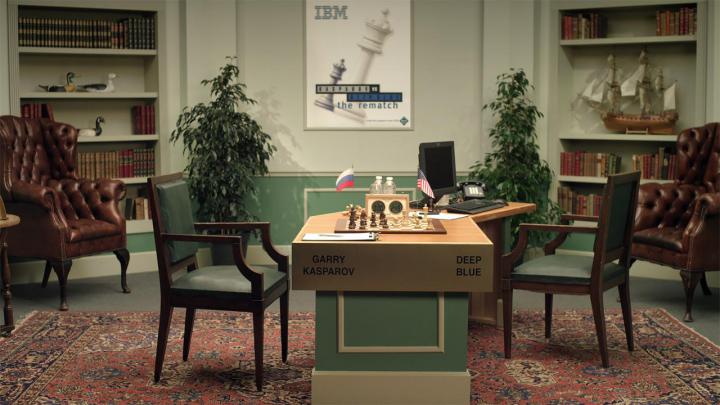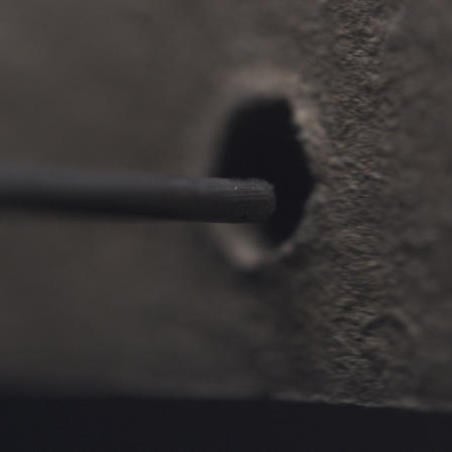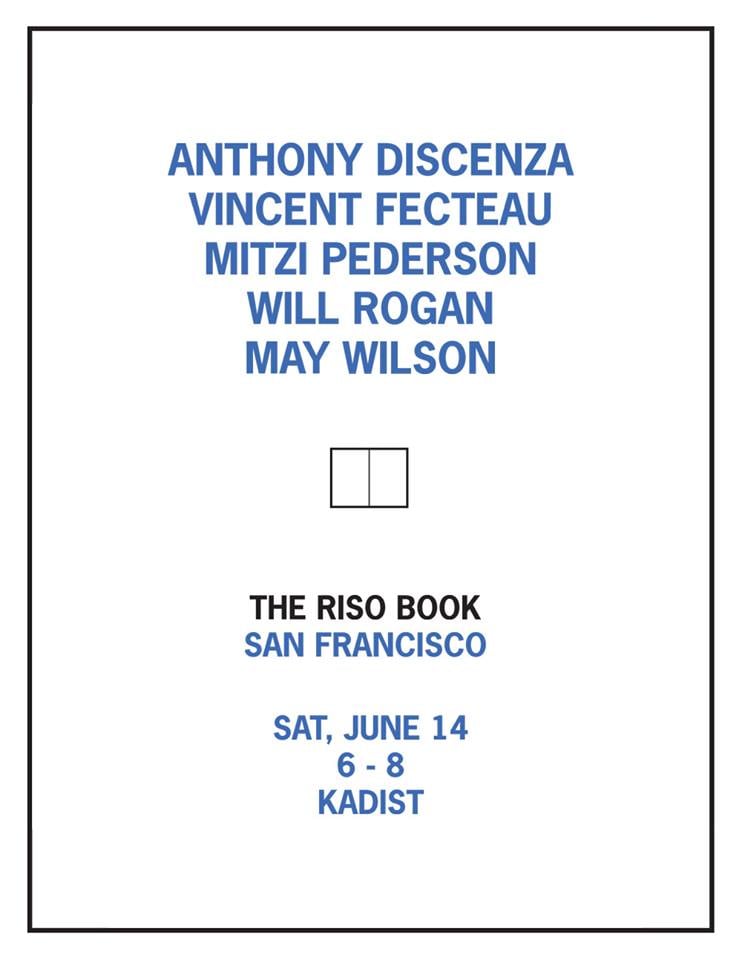
© » KADIST
John Wood and Paul Harrison
One of John Wood and Paul Harrison’s earliest works, Device features Harrison performing a series of actions, assisted by the titular ‘devices’, that use physics to force his body into unusual and uncomfortable positions. Maintaining his signature deadpan expression throughout the video, in one scene Harrison is thrusted into the air by a slowly inflating balloon until only his feet are visible in the frame, while in another he levitates in diving position with the help of a pulley system. Wood uses his body and specially-designed props created by the artist duo to explore the space of the screen in hilarious, and sometimes clumsy or violent, ways.

© » KADIST
Li Xiaofei
Combined into a single two-channel HD video, Li Xiaofei’s Ponytail and Chongming Island II are silent portraits of the women assembly line workers at a Chinese kitchenware factory. Close-up shots of women’s heads—most notably of the rear with their hair in the similar updo fashion—and faces occupy the frame amidst a backdrop of a revolving steel conveyor. In lieu of dialogue or humming of the machinery, a ringing score of chimes and bells provides a tranquil soundtrack.

© » KADIST
John Wood and Paul Harrison
3-Legged is an early video work by John Wood and Paul Harrison in which they appear with their legs tied together (as one would do in a three-legged race). Wood and Harrison stand together in a narrow alcove built into their studio, dressed similarly in grey long sleeve shirts and jeans. Facing a tennis ball machine that is almost completely out of view, with only the barrel of the machine protruding from the bottom of the frame, they hobble back and forth across the alcove attempting to avoid the tennis balls launching toward them, with varying degrees of success.

© » KADIST
Fabien Giraud & Raphael Siboni
– In which defeated he leaves the scene and the stage is left in search of its scale – Second episode of The Unmanned series, “The Brute Force” reconstructs the minutes following Garry Kasparov’s defeat against the IBM Deep Blue computer on 11 May 1997. A camera with computer-programmed movements scrutinises the elements of an empty setting after the chess champion has left the scene, thus abandoning it to the disproportion of a world without its own scale.

© » KADIST
Aura Satz
For her telephone sound composition Dial Tone Drone, Aura Satz commissioned a conversation between two old friends, the sound pioneers Pauline Oliveros (1932-2016) and Laurie Spiegel (born 1945). Carried out via iPhone and Skype and prompted by a series of questions from Satz, the pair congenially discuss aspects of drone sounds, which for years have been an important component of their unconventional electronic work, both audio and video. Their interest in drone sounds and use of sustained or repeated sounds, notes, or tone-clusters aligned with Satz’s own interest in alert signals, and the latter’s attempt to forge a new understanding of hypervigilance and emergency through sound as a perceptual trigger of high alert.

© » KADIST
Lenora de Barros
Lenora de Barros’s poetics are known for setting in motion an intimate relationship between image and the written word. This was precisely one of the questions raised while producing the photographs that compose Poema , one of de Barros’s first and most iconic visual poems. The work consists of a sequence of six black and white photographs where language acts in a performative movement with the typewriter, forging a connection between word and image.

© » KADIST
James "Yaya" Hough
Drawing & Print (Drawing & Print)
This untitled ink and pencil drawing by James “Yaya” Hough is made on what the artist calls “institutional paper”, or the state-issued forms that monitor the daily activities of prisoners, of which, each detainee is generally required to fill out in triplicate. The form used for this drawing details a weekly menu for the prisoners. Hough’s drawing depicts three grimacing figures, riding atop the back of a larger, female figure on all fours.

© » KADIST
Fabien Giraud & Raphael Siboni
– In which an intelligence going back to its place of origin discovers the agony of gods on which it thrives – Seventh and last episode of The Unmanned , “a flood” is set in 1542 as the first conquistadors enter the land later to be known as the Silicon Valley. Mining the colonial past of the region, and entirely generated and edited with an autonomous artificial intelligence system, this film for and by machines only features the return of an intelligence to its place of origin and the death of the animal gods who used to live in it. Closing the series onto itself with a machine trained solely on its first episode (“2045 – The Death of Ray Kurzweil”), it shows the wandering of an inhuman vision trying to revive meaning by recognizing itself on the god’s corpses.

© » KADIST
Rossella Biscotti
Rossella Biscotti’s “10×10” series investigates the relationship between demographics, data processing, textile manufacturing and social structure. The work observes how demographic records have been modeled through the use of punch cards to program both early data processing machines and automated looms (jacquard). Reversing the process, Biscotti turned to the 2001–2006 census information of Brussels—where she was then based—to create a pattern on these textiles.

© » KADIST
Fabien Giraud & Raphael Siboni
-In which predicting its past it lives working and dies fighting- Fifth episode of The Unmanned , “La Mémoire de Masse” unfolds during the second Canuts revolts in Lyon in 1834. These riots now known as the ‘bloody week’ came as a reaction to the automation of work in the silk industry by the Jacquard Loom and its implementation of the punched card – first historical ‘mass storage’ system allowing the inscription and replication of complex weaving patterns. This inaugurating event in the history of workers emancipation movements of the 19th century is actually the first revolt against modern computation.

© » KADIST
James "Yaya" Hough
Drawing & Print (Drawing & Print)
This untitled ink and pencil drawing by James “Yaya” Hough is made on what the artist calls “institutional paper”, or the state-issued forms that monitor the daily activities of prisoners, of which, each detainee is generally required to fill out in triplicate. The form used for this drawing is a request for medical attention. This work illustrates an assembly-line of severed bodies being pumped full of feet and other body parts.

© » KADIST
Fabien Giraud & Raphael Siboni
The Unmanned, is composed of several 26min episodes, it is a fictional documentary about the history of humanity faced with technology acceleration. Each episode dramatizes a “singular” encounter between man and machine. Each episode is filmed with a different camera (a preprogrammed machine or a drone).

© » KADIST
Fabien Giraud & Raphael Siboni
– Thisstoryoffriedrichkurzweiliwanttotellit- myselfhowhelivedinthisroomandh – Inspired by the writings of the feral child Kaspar Hauser and told by the young Friedrich, both father and son of Ray Kurzweil, this story unfolds on the microscope images of a blade cutting through metal. Filmed at the scale of a fold of matter, this cut is the axiom on which the first season of The Unmanned rests.

© » KADIST
Bahar Noorizadeh
After Scarcity is a sci-fi video-essay that tracks Soviet cyberneticians (1950s – 1980s) in their attempt to build a fully-automated planned economy. If history at its best is a blueprint for science-fiction, revisiting contingent histories of economic technology might enable an access to the future. Vindicating this other internet , the work presents the economic application of socialist cybernetic experiments as extraordinary to financial arrangements and imaginations of our time.

© » KADIST
Frieda Toranzo Jaeger
This triptych is based on a Tesla whose interior the artist customized on the Tesla website. The width of the work when the panels are closed is the exact width of a Tesla, thus one designed to hold two bodies side by side. In Mexico City the car is used as a social space and, for young people, one not controlled by parents.

© » KADIST
Fabien Giraud & Raphael Siboni
– In which a storm breaks out in a computing division and its simulation is turned inside out – Fourth episode of The Unmanned series, “The Uncomputable” is the story of a failure: the building in the northern plains of Scotland of a giant climate prediction factory by meteorologist Lewis Fry Richardson. This enormous inverted terrestrial globe supposed to host 64,000 women-computers and able to forecast the world weather was never built. Partly shot in a wind tunnel (used for aerodynamics simulation), this episode shows the impossible attempt at building the factory and the collapse of its hypothesis of a global computation.

© » KADIST
James "Yaya" Hough
Drawing & Print (Drawing & Print)
This untitled ink and pencil drawing by James “Yaya” Hough is made on what the artist calls “institutional paper”, or the state-issued forms that monitor the daily activities of prisoners, of which, each detainee is generally required to fill out in triplicate. This drawing uses a pink form on which an inmate can list telephone contacts for approval. The drawing depicts two uniformed figures, with backwards feet, berating a figure on a toilet.

© » KADIST
Yang Guangnan
Itch explores the relationship between technology and daily human experience with a motorized arm that extends from within the gallery’s wall, moving up and down while holding a projector that shows a desperately scratching pair of hands.

© » KADIST
Michael Landy
H.2. N. Y Skeleton of the Dump revolves entirely around the performance “Homage to New York” (1960), of the Swiss artist Jean Tinguely (1925-1991), during which the machine built by the artist in the gardens of the Museum of Modern Art (MOMA) had to self-destruct itself in 27 minutes, but, in the end, it had to be finished off by firemenbeing called in after it erupted in flames. Since the discovery of Jean tinguely’s retrospective at the Tate Gallery in London, in 1982, Michael Landy spent two years researching and sketching (charcoal, oil, glue, ink) from his previous research carried out at Museum Tinguely in Basel, and at the MOMA in New York.

© » KADIST
Keith Tyson
The work of Keith Tyson is concerned with an interest in generative systems, and embraces the complexity and interconnectedness of existence. Philosophical problems such as the nature of causality, the roles of probability and design in human experience, and the limits and possibilities of human knowledge, animate much of his work. Language as a coded system, as a representation medium, but also as something that generates a whole variety of realities also plays a central role.

© » KADIST
Yang Zhenzhong
Peasant Sensation Passing Through Flesh – 3 consists of a massage chair fixed to a wall. With its cushions removed to reveal its internal mechanisms, the chair’s programmed rubbing, kneading, patting, and vibrating motions create a strange sight and soundscape. The work explores the relationship between flesh and machine as they come together through technologically simulated social behaviors, challenging normative ideas about human interaction.

© » KADIST
Piero Golia
Golia’s Untitled 3 is an installation in which a mechanical device is programmed to shoot clay pigeons that are thrown up in front of a white wall. More than a simple reference to the sport, the work has the disconcerting effect of creating a danger zone in the gallery space. The reference to direct aggression or violence is reinforced by the piece’s rapid pace.
Fabien Giraud & Raphael Siboni
The collaborative work of Fabien Giraud and Raphael Siboni is part of a reflection on the history of cinema, science, and technology...
James "Yaya" Hough
Working in ballpoint pen, pencil, and watercolor, often on the backs of bureaucratic prison forms, James “Yaya” Hough’s work conveys the burdens of incarcerated life, revealing not only the brutal reach of the carceral system, but laying bare its affects...
John Wood and Paul Harrison
John Wood and Paul Harrison have been working collaboratively since 1993, producing single screen and installation-based video works...
Piero Golia
- location: Los Angeles, California
- year born: 1974
- gender: male
- nationality: Italian
- home town: Naples, Italy
Bahar Noorizadeh
Bahar Noorizadeh is filmmaker, writer, and platform designer...
Aura Satz
Aura Satz is a London-based visual artist whose work encompasses film, performance and sculpture and emphasizes the complex relationship between humans and machines...
Frieda Toranzo Jaeger
Many of Frieda Toranzo Jaeger’s works take the triptych format, employed by artists over many centuries to represent religious devotion...
Li Gang
Li Gang’s practice creates a meticulous and poetic balance between materiality and conceptuality...
Lenora de Barros
Lenora de Barros studied linguistics and started her artistic career in the 1970s...
Yang Guangnan
- location: New York City, United States
- year born: 1986
- home town: Inner Mongolia, China
Li Xiaofei
Li Xiaofei initiated Assembly Line in 2010, an ongoing project that records industrialized social change not only China, but as it occurs internationally...
Michael Landy
- location: London, United Kingdom
- year born: 1963
- gender: male
- nationality: British
Yang Zhenzhong
- location: Shanghai, China
- year born: 1968
- gender: male
- nationality: Chinese
- home town: Xiaoshan, China
Rossella Biscotti
Departing from social and political history, the work of Rossella Biscotti (b...
Keith Tyson
- location: Ulverston, United Kingdom
- year born: 1969
- gender: male
- nationality: British
-
1990-1999
John Wood and Paul Harrison
1996One of John Wood and Paul Harrison’s earliest works, Device features Harrison performing a series of actions, assisted by the titular ‘devices’, that use physics to force his body into unusual and uncomfortable positions...
John Wood and Paul Harrison
19973-Legged is an early video work by John Wood and Paul Harrison in which they appear with their legs tied together (as one would do in a three-legged race)...
-
2000-2009
Piero Golia
2007Golia’s Untitled 3 is an installation in which a mechanical device is programmed to shoot clay pigeons that are thrown up in front of a white wall...
-
2010-2019
Yang Guangnan
2011Itch explores the relationship between technology and daily human experience with a motorized arm that extends from within the gallery’s wall, moving up and down while holding a projector that shows a desperately scratching pair of hands....
Yang Zhenzhong
2012Peasant Sensation Passing Through Flesh – 3 consists of a massage chair fixed to a wall...
Fabien Giraud & Raphael Siboni
2014– In which defeated he leaves the scene and the stage is left in search of its scale – Second episode of The Unmanned series, “The Brute Force” reconstructs the minutes following Garry Kasparov’s defeat against the IBM Deep Blue computer on 11 May 1997...
Rossella Biscotti
2014Rossella Biscotti’s “10×10” series investigates the relationship between demographics, data processing, textile manufacturing and social structure...
Fabien Giraud & Raphael Siboni
2014The Unmanned, is composed of several 26min episodes, it is a fictional documentary about the history of humanity faced with technology acceleration...
Fabien Giraud & Raphael Siboni
2014– Thisstoryoffriedrichkurzweiliwanttotellit- myselfhowhelivedinthisroomandh – Inspired by the writings of the feral child Kaspar Hauser and told by the young Friedrich, both father and son of Ray Kurzweil, this story unfolds on the microscope images of a blade cutting through metal...
Fabien Giraud & Raphael Siboni
2015-In which predicting its past it lives working and dies fighting- Fifth episode of The Unmanned , “La Mémoire de Masse” unfolds during the second Canuts revolts in Lyon in 1834...
James "Yaya" Hough
Drawing & Print
2016(Drawing & Print) This untitled ink and pencil drawing by James “Yaya” Hough is made on what the artist calls “institutional paper”, or the state-issued forms that monitor the daily activities of prisoners, of which, each detainee is generally required to fill out in triplicate...
James "Yaya" Hough
Drawing & Print
2016(Drawing & Print) This untitled ink and pencil drawing by James “Yaya” Hough is made on what the artist calls “institutional paper”, or the state-issued forms that monitor the daily activities of prisoners, of which, each detainee is generally required to fill out in triplicate...
James "Yaya" Hough
Drawing & Print
2016(Drawing & Print) This untitled ink and pencil drawing by James “Yaya” Hough is made on what the artist calls “institutional paper”, or the state-issued forms that monitor the daily activities of prisoners, of which, each detainee is generally required to fill out in triplicate...
Frieda Toranzo Jaeger
2017This triptych is based on a Tesla whose interior the artist customized on the Tesla website...
Bahar Noorizadeh
2018After Scarcity is a sci-fi video-essay that tracks Soviet cyberneticians (1950s – 1980s) in their attempt to build a fully-automated planned economy...
Fabien Giraud & Raphael Siboni
2018– In which an intelligence going back to its place of origin discovers the agony of gods on which it thrives – Seventh and last episode of The Unmanned , “a flood” is set in 1542 as the first conquistadors enter the land later to be known as the Silicon Valley...
-
2020-2029
Lenora de Barros
2021Lenora de Barros’s poetics are known for setting in motion an intimate relationship between image and the written word...







